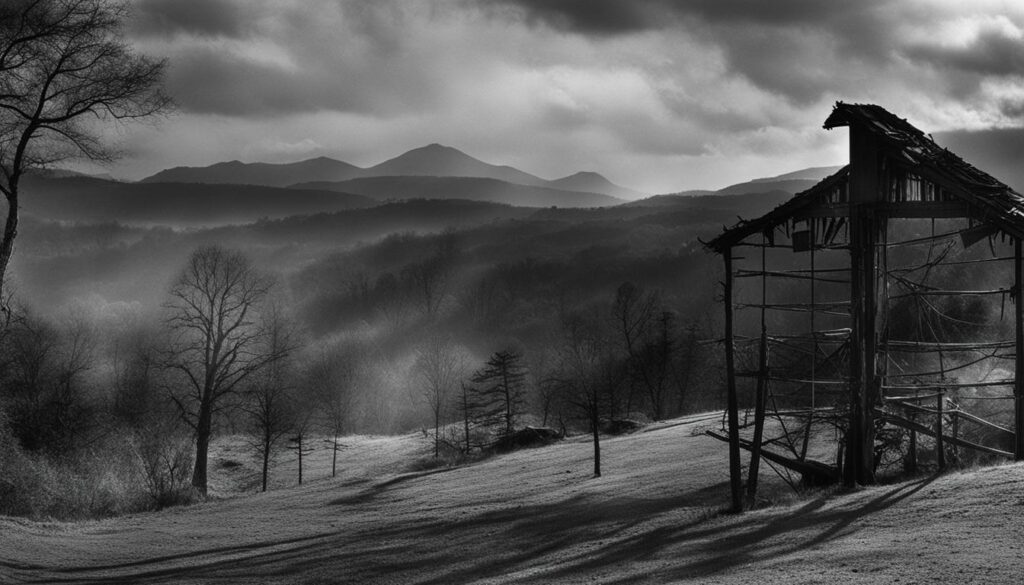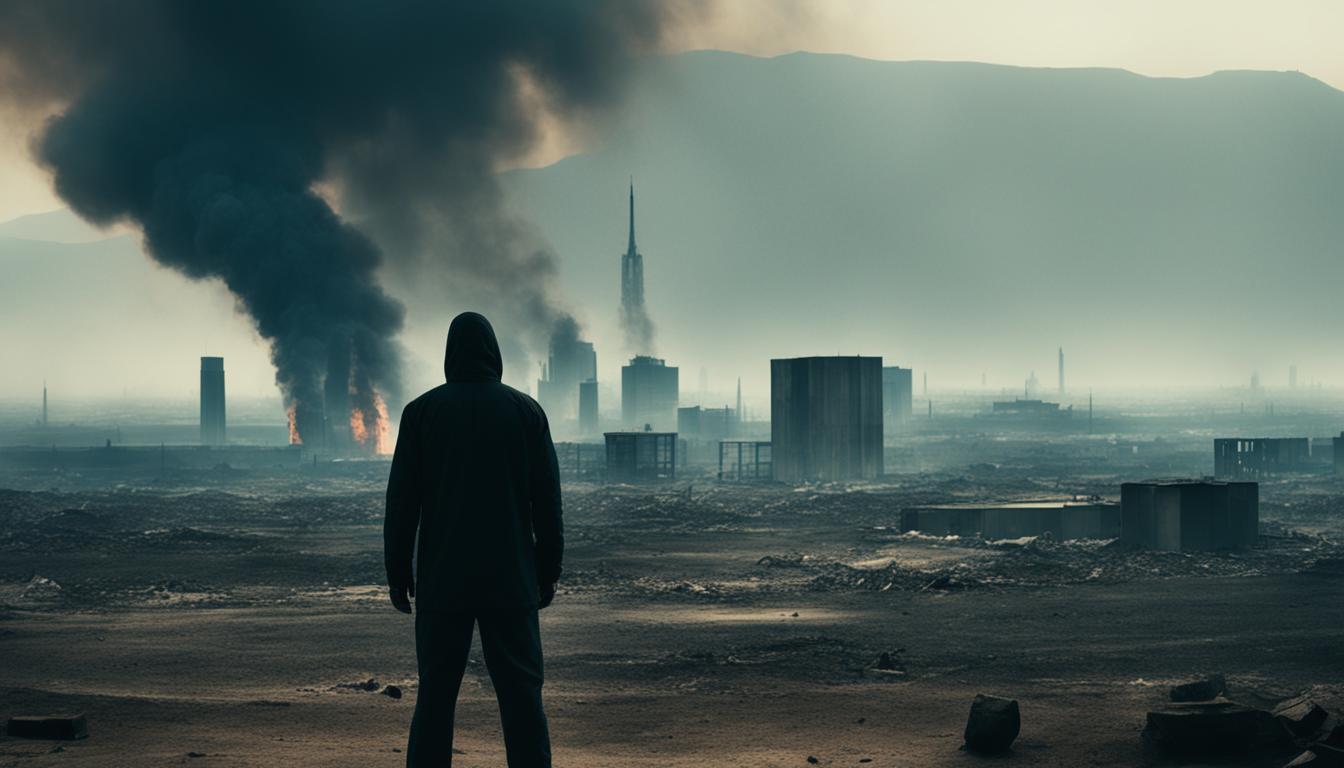The Stand, a post-apocalyptic masterpiece written by Stephen King, is a gripping tale of human survival and the battle between good and evil. It encompasses a world ravaged by a devastating plague, where a small number of survivors must come together and fight for the future of humanity.
Key Takeaways:
- The Stand is a post-apocalyptic novel written by Stephen King.
- The plot revolves around a world devastated by a deadly plague.
- The story explores the epic battle between good and evil.
- The characters must navigate a dangerous new world and fight for the future of humanity.
- The Stand is recognized as a seminal work in the post-apocalyptic genre.
Introduction to The Stand
Stephen King’s iconic novel, The Stand, is a mesmerizing and chilling tale set against the backdrop of a post-apocalyptic world. The novel, first published in 1978, tells the story of a deadly virus that wipes out most of the world’s population, leaving behind only a small group of survivors. These survivors must navigate a dangerous and desolate landscape in search of hope, redemption, and a new beginning.
The Stand is widely regarded as a masterpiece of post-apocalyptic literature, and Stephen King’s evocative storytelling and engrossing characters have captivated readers for decades. The novel has been adapted into various media, including a popular 1994 television mini-series and a 2020 streaming series, bringing the characters and themes of the story to a wider audience.
The Initial Outbreak and Death Toll
The Stand by Stephen King is set in a post-apocalyptic world that is brought about by a deadly outbreak of the Captain Trips virus, which kills nearly all of humanity. The terrifying virus is extremely contagious and spreads rapidly, causing a death toll of epic proportions.
As the world faces its darkest hour, the survivors must band together and forge new alliances if they hope to rebuild and thrive in the aftermath of the outbreak. The Stand provides a haunting and all too real depiction of the chaos that can follow a global pandemic, making it a gripping read that is sure to stay with readers long after they have finished.
The outbreak in The Stand is a powerful reminder of the devastating impact that such events can have on our world. As we continue to battle pandemics in the real world, this novel serves as a stark warning of the potential consequences if we fail to take the necessary precautions and work together to prevent their spread.
The Survivors and Their Paths
After the deadly outbreak in The Stand, a variety of survivors emerged who slowly found their paths through the new post-apocalyptic world. Some of the notable survivors are Stu Redman, a resilient Texan with a mysterious immunity to the disease; Frannie Goldsmith, a pregnant teenager searching for safety and answers; Harold Lauder, a sullen and insecure teenager with a dark agenda; and Nick Andros, a deaf-mute wanderer with a compassionate heart.
As they travel across the desolate landscape, they encounter others who have also survived the outbreak, such as the Mother Abigail-led Boulder Free Zone, where a community of survivors have banded together to fight for their future. Each character’s path is unique and intertwines with the paths of others, leading to unexpected alliances and betrayals.
The complex relationships and individual journeys of these survivors are a major component of The Stand’s gripping narrative, highlighting the struggle for purpose and survival in a world radically altered by a catastrophic event.
The Two Factions: Good vs. Evil
As with many of Stephen King’s works, The Stand centers around the classic struggle between good and evil. It is a story of two factions, with the forces of good and evil battling for control and dominance over what remains of the world. The sides are not clearly defined, as characters’ motivations and allegiances shift throughout the course of the novel. The journey of the different factions and their members form the backbone of the story, as they face off in a battle of epic proportions.
One of the most interesting aspects of the novel is the way in which human nature is portrayed, with characters displaying both good and evil traits. The emotions of fear and desperation are what drive many of the characters to choose one side or the other, with the end result being a clash of ideologies that is both compelling and thought-provoking.
The Good:
The “good” faction in The Stand is comprised of a group of survivors who are determined to create a new society that is free from the influence of The Dark Man. This group is led by Abigail Freemantle, who is viewed as a prophetic figure by many of the other survivors. She is a symbol of hope, and her message inspires many to join her cause and fight against the forces of evil.
Larry Underwood is another central character who emerges as a leader among the “good” group. He is a former rockstar who is forced to confront his own demons in order to become the hero he needs to be. Together, this group embarks on a journey to build a better world, even as they face insurmountable odds.
The Evil:
The faction representing the “evil” entity consists of a different group of survivors. Led by Randall Flagg, The Dark Man, this group seeks to impose their will upon the rest of the world, and destroy those who oppose them.
Flagg represents the ultimate embodiment of evil and chaos, and his followers are equally unscrupulous. They believe that only the strong deserve to survive, and they will stop at nothing to achieve their goals.
The battle between these two factions is one of the most compelling aspects of The Stand, and serves as an allegory for the struggle between good and evil that exists in every human heart.
Randall Flagg: The Dark Man
Randall Flagg, also known as The Dark Man, is a mysterious and malevolent character that plays a central role in The Stand. He is a powerful and manipulative individual, capable of twisting reality to his will, and gathering a devoted following of followers who do his bidding.
Flagg is portrayed as a relentless antagonist throughout The Stand, with his enigmatic nature and supernatural abilities making him a terrifying force to be reckoned with. He is shown to be a master of deceit, using his charisma and cunning to manipulate those around him and further his own dark desires.
Despite his malevolent nature, Flagg is a complex and multi-dimensional character, with his motivations and backstory explored in detail throughout The Stand. His origins and true nature are left ambiguous, adding to the intrigue and suspense surrounding his character.
The Gathering of the Boulder Free Zone
As the survivors of the devastating outbreak in The Stand come to terms with their new reality, a community of individuals band together to form the Boulder Free Zone. Led by the wise and compassionate Mother Abagail, the Boulder Free Zone provides a sense of stability and hope for those seeking refuge.
Throughout the novel, we witness the community’s efforts to rebuild society and prepare for the inevitable clash with the dark forces led by Randall Flagg. The gathering of the Boulder Free Zone represents the triumph of human connection and compassion in the face of unimaginable chaos.

Their shared goal to resist evil and establish a new society is a testament to the human spirit. By coming together and pooling their resources and skills, they demonstrate the power of collective action and working towards a common cause. This gathering also presents an inspiring message of hope and resilience, underscoring the idea that even in the darkest of times, we can come together and overcome adversity.
The Battle for the Future
The Stand culminates in a climactic battle between good and evil, in which the fate of humanity hangs in the balance. The two factions, led by Mother Abagail and Randall Flagg, respectively, clash in an epic struggle for dominion over the shattered remains of civilization.
Despite being outnumbered, Flagg’s army possesses formidable supernatural powers and uses them to devastating effect. However, the humans of the Boulder Free Zone prove to be resilient and resourceful, and they mount a fierce resistance against Flagg’s forces.
The battle for the future of humanity is brutal and harrowing, resulting in significant casualties on both sides. However, in the end, good manages to triumph over evil with the help of unexpected allies and sacrifice.
The Stand’s depiction of a decisive showdown between good and evil has resonated with readers for decades, cementing its status as a post-apocalyptic masterpiece and a timeless classic of the genre.
Themes and Symbolism in The Stand
Stephen King’s The Stand is a complex narrative that explores various themes of morality, spirituality, and human nature. One of the most prominent themes in the novel is the battle between good and evil, with characters representing both sides of the divide. The struggle between these forces is a symbolic representation of the dichotomy between right and wrong, and the choices that individuals make in their lives.
Another key theme in The Stand is the idea of community and the strength that comes with unity. The novel presents a vision of a world where people come together to fight against a common enemy, defying their individualistic tendencies in favor of collective action. This message of hope and unity resonates strongly with readers.
The symbolism in The Stand is equally complex, with various allegorical references to religion, mythology, and history. For example, the character of Randall Flagg is a symbol of chaos and destruction, embodying the destructive potential of human nature. On the other hand, the Boulder Free Zone represents hope and regeneration, showcasing the potential for individuals to come together and rebuild society.
Overall, the themes and symbolism in The Stand elevate the novel beyond the confines of typical post-apocalyptic fiction, making it a thought-provoking and timeless work of literature.
Critical Reception and Impact
The Stand by Stephen King has garnered widespread critical acclaim since its publication in 1978. The novel’s intricate and vividly portrayed post-apocalyptic world, along with its memorable characters and themes, has resonated with readers and critics alike.
The book has been praised for its intricate plotting and skillful blend of horror, science fiction, and fantasy. Critics have also lauded King’s ability to create a sense of foreboding and dread throughout the narrative.
The Stand’s impact on the literary world has been significant, solidifying Stephen King’s reputation as one of the most influential voices in contemporary fiction. The novel has been adapted into various forms of media, including a critically acclaimed television miniseries and a comic book adaptation. It continues to inspire readers and writers alike, firmly cementing its place in the annals of post-apocalyptic literature.

Characters in The Stand
Stephen King’s The Stand features a diverse cast of memorable characters who play pivotal roles in the battle between good and evil. The protagonist, Stu Redman, is a soft-spoken, pragmatic Texan who becomes a leader among the survivors. Frannie Goldsmith, a pregnant young woman, is another central figure who discovers her inner strength as she adapts to the post-apocalyptic world.
Other notable characters include the enigmatic Nick Andros, who is deaf and mute but possesses a keen intelligence, and Harold Lauder, a socially awkward outcast who harbors a dangerous obsession with Frannie. Randall Flagg, the malevolent Dark Man who embodies evil, is another crucial character who appears throughout the novel.
The Stand also features an array of supporting characters, including doctors, soldiers, and everyday citizens who must contend with the challenges of survival in a world decimated by disease and chaos. Together, these characters create a rich and complex narrative that explores the best and worst of human nature in the face of adversity.
Conclusion and Legacy
In conclusion, The Stand by Stephen King remains a post-apocalyptic masterpiece that captivates readers with its epic battle of good versus evil. The novel has a lasting legacy and continues to influence the literary world and popular culture.
King’s vivid and detailed descriptions of the post-apocalyptic world and his complex characters make The Stand a standout work in the genre. The story’s themes of community, survival, and hope in the face of adversity resonate with readers, making it a timeless piece of fiction.
The Stand’s impact on the literary world cannot be overstated. It has inspired countless post-apocalyptic works, movies, and TV shows, cementing its place as a seminal work in the genre.
Overall, The Stand is a must-read for fans of Stephen King and those who enjoy post-apocalyptic fiction. Its legacy continues to thrive, and it remains a testament to King’s storytelling prowess and his ability to captivate readers with his imaginations.
FAQ
What is The Stand about?
The Stand is a post-apocalyptic novel by Stephen King that explores the epic battle between good and evil in a world devastated by a deadly virus.
Who is the author of The Stand?
The Stand is written by the renowned author, Stephen King.
What genre does The Stand belong to?
The Stand can be categorized as a post-apocalyptic masterpiece.
What is the setting of The Stand?
The Stand is set in a post-apocalyptic world where society has collapsed due to a deadly virus.
What is the initial outbreak in The Stand?
The initial outbreak in The Stand refers to the emergence of a deadly virus that wipes out a significant portion of the population.
How does The Stand explore the theme of good vs. evil?
The Stand showcases the conflict between the forces of good and evil as the survivors navigate the post-apocalyptic world.
Who is Randall Flagg in The Stand?
Randall Flagg, also known as The Dark Man, is an enigmatic and malevolent character central to the plot of The Stand.
What is the Boulder Free Zone in The Stand?
The Boulder Free Zone is a community of survivors in The Stand who unite against the forces of evil.
What is the climactic battle in The Stand?
The climactic battle in The Stand refers to the ultimate conflict between good and evil, determining the future of humanity.
What are the key themes and symbolism in The Stand?
The Stand explores themes such as the battle between good and evil, the resilience of the human spirit, and the nature of power. It also employs symbolism to convey deeper meaning.
How was The Stand received by critics?
The Stand garnered positive critical reception and is considered a prominent work by Stephen King.
Who are the memorable characters in The Stand?
The Stand features a cast of memorable characters, each with their own motivations and roles in the story.
What is the legacy of The Stand?
The Stand has left a lasting impact on readers and the genre of post-apocalyptic fiction, solidifying its place as a significant contribution by Stephen King.



